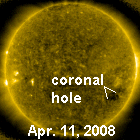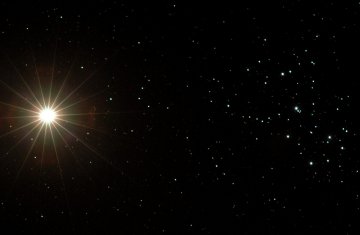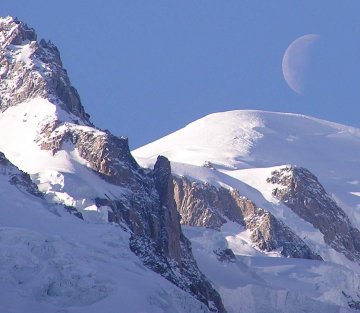|   SPACE WEATHER SPACE WEATHER
Current
Conditions
Solar Wind
speed: 462.8 km/s
density: 1.2 protons/cm3
explanation | more data
Updated: Today at 2245 UT X-ray Solar Flares
6-hr max: A0 2245 UT Apr12
24-hr: A0 1215 UT Apr12
explanation | more data
Updated: Today at 2245 UT
Daily Sun: 12 Apr '07

The sun is blank today--no sunspots. Credit: SOHO/MDI
Sunspot Number: 0
What is the sunspot number?
Updated: 11 Apr 2007 Far Side of the Sun

This holographic image reveals no sunspots on the far side of the sun. Image credit: SOHO/MDI Interplanetary Mag. Field
Btotal: 3.3 nT
Bz: 1.0 nT north
explanation | more data
Updated: Today at 2246 UT Coronal Holes:

Earth is inside a weak solar wind stream flowing from the indicated coronal hole. Credit: SOHO Extreme UV telescope
 SPACE WEATHER SPACE WEATHER
NOAA
Forecasts
Solar Flares: Probabilities for a medium-sized (M-class) or a major (X-class) solar flare during the next 24/48 hours are tabulated below.
Updated at 2007 Apr 12 2203 UTC
| FLARE | 0-24 hr | 24-48 hr | | CLASS M | 01 % | 01 % | | CLASS X | 01 % | 01 % |
Geomagnetic Storms: Probabilities for significant disturbances in Earth's magnetic field are given for three activity levels: active, minor storm, severe storm
Updated at 2007 Apr 12 2203 UTC
Mid-latitudes | 0-24 hr | 24-48 hr | | ACTIVE | 15 % | 15 % | | MINOR | 05 % | 05 % | | SEVERE | 01 % | 01 % |
High latitudes | 0-24 hr | 24-48 hr | | ACTIVE | 15 % | 15 % | | MINOR | 05 % | 05 % | | SEVERE | 01 % | 01 % |
|  Did you miss last night's auroras? Next time get a wake-up call from Spaceweather PHONE. Did you miss last night's auroras? Next time get a wake-up call from Spaceweather PHONE.
BLANK SUN: The sunspot number has been zero for nine consecutive days. This may seem like a long time, but the sun can go much longer without sunspots. For instance, during the previous solar minimum in 1996, the sun was once blank for 37 consecutive days. How long will the current "blank" last? Stay tuned. VENUS AND THE PLEIADES: Tonight, for the third night in a row, you can see Venus beautifully close to the Pleiades. Simply look west after sunset. The planet-star cluster combo is not only pleasing to the naked eye but also a fun target for cameras: 
Photo details: Fuji FinePix S2 Pro, 300 mm Nikkor lens at f5.6 , ISO 800.
"This is a 4-minute guided exposure," says physics professor Jimmy Westlake of Stagecoach, Colorado. "An 18-bladed diaphragm in the lens created the spikes in the overexposed image of Venus, but the results are pretty spectacular." more images: from Jan Koeman of Kloetinge, The Netherlands; from Michel Hersen of Portland, Oregon; from Guillaume Poulin of Mont-Megantic, Quebec, Canada; from Gerhard Dangl of Nonndorf, Austria; from Steve Irvine of Big Bay, Ontario; from Thad V'Soske on the banks of the Colorado river; from Peter Heinzen of Raron, Switzerland; from Tunc Tezel near Bolu, Turkey; from Pete Lawrence of Selsey, UK; from Svetozar Stefecek of Sobotiste, Slovakia; from Henk Bril of Breberen, Germany; from Derick Rethans of Skien, Norway; from Remus Nicolaescu of Bucharest, Romania; from Bryan Murahashi of San Jose, CA; MOON BLANC: "This view really impressed me when I woke up yesterday," says photographer Yasmin Walter of Chamonix Mt. Blanc, France. "The half moon seemed to be climbing onto Mont Blanc," both mountain and Moon as white as snow: 
Photo details: Olympus Camedia C-740, automatic exposure
Appearances can be deceiving. While the Moon in broad daylight has the soft white look of snow, it is certainly not snowy. If you stuck a thermometer in the sunlit moondust it would read about 110o C. That's probably why most of the Moon's surface is bone dry: all the water has all boiled away. For all that, it's still a pretty sight, and this is a good morning to enjoy it. Step outside after breakfast, look south and see the Moon Blanc for yourself. | 
Potentially Hazardous Asteroids (PHAs) are space rocks larger than approximately 100m that can come closer to Earth than 0.05 AU. None of the known PHAs is on a collision course with our planet, although astronomers are finding new ones all the time.
On 12 Apr 2007 there were 855 known Potentially
Hazardous Asteroids April 2007 Earth-asteroid encounters | ASTEROID | DATE
(UT) | MISS DISTANCE | MAG. | SIZE
| | 2006 VV2 | Mar. 31 | 8.8 LD | 10 | 2 km | | 2007 FY20 | Apr. 2 | 5.3 LD | 19 | 50 m | | 2007 DS84 | Apr. 14 | 16 LD | 15 | 325 m | Notes: LD is a "Lunar Distance." 1 LD = 384,401 km, the distance between Earth and the Moon. 1 LD also equals 0.00256 AU. MAG is the visual magnitude of the asteroid on the date of closest approach.
|

